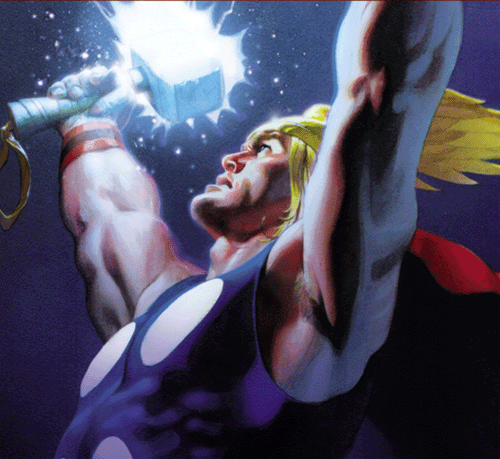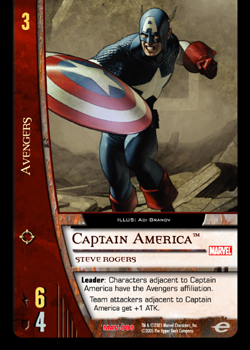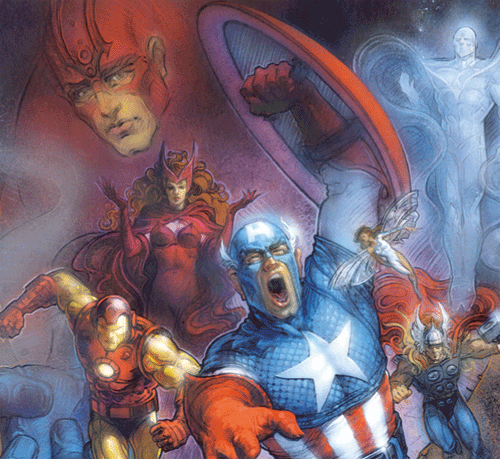Dawn of the Avengers
1963. The Fantastic Four had changed the entire shape of the comic industry by showing the “human” side of superheroes. In the slipstream of Marvel’s First Family came Spider-Man; The Hulk; Thor in Journey into Mystery; and Iron Man, Ant-Man, and the Wasp in Tales of Suspense. But DC had the Justice League, a team of superheroes with no connection to each other, unlike the Fantastic Four family. Each had superhuman powers, and they teamed up to battle immensely powerful foes.
Marvel had to respond; they were already pioneers in the industry who had combined super-heroism and realism at a level never seen before. While there were various war comics in the 40s that focused on the harsh realities of life and of war, none of them focused on humanity and interpersonal relationships. Those that did didn’t revolve around superheroes. With the growing popularity of their roster of superheroes and a demand for more crossovers and guest appearances, Stan Lee decided that it was time for Marvel to create their own team of unrelated superheroes. He took some of the most popular Marvel characters and thrust them into their own super-team, and thus the Avengers were born!
The original team consisted of Iron Man, Thor, The Hulk, Ant-Man, and the Wasp, plus the Hulk’s friend, Rick Jones, who was granted honorary membership. Iron Man’s power came from his armor, which had many tricks up its sleeves (from boot jets to Repulsor Rays) and provided Tony Stark with a computer display of his environment and surroundings. This gave him a distinct tactical advantage, and it is why his cards grant him an advantage while equipped or give friendly fighters the advantage of flight and range.
Hulk, at that point, was an unstable mass of emotions, primarily anger and rage supported by feelings of distrust and loneliness. He was also really big, really strong, and due to the gamma rays he had absorbed, had a very thick skin and fast regenerative powers. His card reflects his recuperative ability with his non-stun effect and his boil-over—he doesn’t just not stun; he actually gets bigger when you hit him hard enough.
Ant-Man was never the strongest of the Avengers, nor of Hank Pym’s various personae. But when working in tandem with others, particularly the Wasp, he would become more and more useful, especially when using his ability to summon his six-legged friends. That is why his card promotes teamwork by doubling his attack effectiveness when he’s working alongside someone else.
Wasp was much the same, though her Wasp stings made her a more formidable opponent. A born leader, Janet Van Dyne would serve as chair(wo)man of the Avengers for a long time. Her card reflects the push for teamwork and teamwork strategy by giving adjacent characters stun-free team-attacks.
Finally, Thor rounded out the team as by far the most powerful and dramatic of members. Wielding the formidable Mjolnir, the Thunder God would Call Down the Lightning, using the powers of the storms to create havoc and destruction while quelling any threat. His God of Thunder version shows how everyone alongside him on the battlefield got a little stronger—pride and morale would rise as he tirelessly fought on. His Odinson version shows the proud and arrogant Thor, willing to take down the very walls around him to defeat his enemies; you sacrifice the top card of your deck, but it’s gonna hurt your opponent. As the first equipment tagged to a specific character, Mjolnir is a formidable card. It was the focal point of Thor’s power; in the early days, if Thor let go of his hammer for more than thirty seconds, he would revert back to the sickly Dr. Donald Blake. This is why, when holding the hammer, Thor gets bigger and fiercer. Its other ability (it functions as a Thor search card) reflects the fact that whenever Thor threw his hammer, it always returned to his hand.

The Journey Begins
The team actually came together by accident. Loki wanted to kill his half-brother, Thor. So he set up an elaborate scenario, causing a railway accident and framing the Hulk for it. Rick Jones, knowing that the Hulk was innocent, sent out a distress call to the Fantastic Four to clear his friend’s name. Loki intercepted the signal and re-routed it to Thor, hoping that he would fight the Hulk and be vanquished. It was inadvertently intercepted by three other heroes, as well—Iron Man, Ant-Man, and the Wasp—who each joined Thor and helped him to track the Hulk down. After finding him, they realized that Hulk was indeed not to blame, and after discovering Loki’s mischievous workings, they banded together (Hulk included) to take Loki down.
Upon capturing Loki, Ant-Man suggested that the fivesome remain a team, and each member pledged their allegiance. Wasp suggested the name “Avengers”—a team dedicated to avenging evil—and all of the members agreed. This would begin a long journey of new members joining, old members leaving, and some returning, with many a super-villain battled and vanquished along the way. Iron Man’s “boss,” Tony Stark, who unbeknownst to the other Avengers was Iron Man himself, became the Avengers’ benefactor. He allowed them the use of a mansion he owned in midtown Manhattan (on 5th and 71st). This would become known as the AvengersMansion. His personal butler, Jarvis, would move into the mansion and serve the Avengers faithfully for years and years to come, outlasting both the Mansion and several incarnations of the Avengers. Jarvis would spend much time monitoring the mansion and its computers, where he was only the press of a button away from several Avengers wearing communicators. This is why, when attacked, he can run away and summon Avengers to help defend him and the mansion. Finally, to ensure that Stark’s own finances never affected the Avengers, he set up The Maria Stark Foundation, which kept money aside for the Avengers’ sundry expenses.
The downs would begin before the ups did, as the Space Phantom struck almost immediately after their tangle with Loki. With the Space Phantom sowing the seeds of distrust among the Avengers, the axe fell on the Hulk, who in a typical emotional outburst was the Avenger to leave the fold.
 It didn’t take long to find a replacement, though, as the team discovered one of the greatest heroes ever to walk the Marvel Earth, Captain America, frozen in an iceberg. The war hero, long presumed dead, thawed out and moved into the mansion. Though it took a while to adjust to a world that had so drastically changed over the decades, Steve Rogers was never really out of place, as he championed the values that he represented by wearing the colors and symbols of his country—the same values of justice, liberty, and freedom that made the Avengers, who upheld those values, the Earth’s Mightiest Heroes.
It didn’t take long to find a replacement, though, as the team discovered one of the greatest heroes ever to walk the Marvel Earth, Captain America, frozen in an iceberg. The war hero, long presumed dead, thawed out and moved into the mansion. Though it took a while to adjust to a world that had so drastically changed over the decades, Steve Rogers was never really out of place, as he championed the values that he represented by wearing the colors and symbols of his country—the same values of justice, liberty, and freedom that made the Avengers, who upheld those values, the Earth’s Mightiest Heroes.
His history and iconic symbolism made Captain America an immediate role model to his fellow members, and his dedication to training and discipline were what changed the Avengers from a group of heroes into a smoothly running teamwork machine. He would lead the Avengers several times, which is why both of his versions are leaders and why everyone around him simply becomes a better asset when he’s on the field.
Over the next little while, the Avengers would run into Kang the Conqueror and get their first taste of the Masters of Evil, then led by Heinrich Zemo, Captain America’s longtime nemesis and the indirect killer of Captain America’s war-time sidekick, Bucky. Zemo would also introduce the Avengers to a future member, Simon Williams (the Wonder Man), who would sacrifice his life to prevent the Avengers’ demise at the hands of Zemo’s hoodlums. Wonder Man would later be revived by his brother, the Grim Reaper, and would also be indirectly responsible for the creation of the Vision, whose synthezoid mind was modeled after Simon Williams’s brain patterns.
The Avengers would undergo several changes over the years. When the original members took a leave of absence, their spots were filled by former criminals Hawkeye, Scarlet Witch, and Quicksilver. Each had heaps of trust bestowed upon them by Captain America and his fellow freedom fighters, as he and the rest of the Avengers championed redemption and second chances. Hawkeye would be particularly affected by this second chance, later joining and then leading the Thunderbolts—a group of former villains who were trying to redeem themselves.
Avengers and the Government
The Avengers were the first team to be officially government sanctioned. Although they didn’t work directly for the government (like the Ultimates did), they had government approval and support, their computer databases were directly connected to those of the US military, and they even had limited access to SHIELD and Interpol databases. As well, the Quinjets were allowed to take off and land directly from the mansion and enter and leave US airspace. Avengers members even received permanent living space at the mansion and monthly stipends to cover their daily needs and expenses.
At one point, the National Security Council decided that the Avengers’ level of security and access was getting out of hand, so they appointed Henry Peter Gyrich as a liaison to the Avengers to tighten the purse strings, so to speak. Gyrich initiated several new policies, including restricted membership and strict admission requirements. When he began to go overboard in an effort to include affirmative action measures, and then almost eliminated the Avengers’ access to their computer databases, they moved to have him removed. He was eventually replaced by Raymond Sikorsky, who was much more moderate and open to compromise. Captain America decided to appease the Council by instituting a six-member cap that has remained in place ever since. Left with dozens of reserve members, many of whom wished to be active, Vision suggested forming a second team to handle the excess. Hawkeye led a contingent out to Los Angeles and they became the West Coast Avengers. They were a completely independent team, but they shared information and responsibilities with the core group.

The government has bandied back and forth in regard to the Avengers and their clearances. The team lost much of their access to the government databases, and were at one point forced to build a Hydrobase (which they later named AvengersIsland) from which to launch their Quinjets when the government restricted their airspace privileges.
The Avengers function as a non-profit organization, with a rotating chairmanship and voting rights for all of their members. They have a charter and bylaws, as any organization does, that carefully cover membership rights and responsibilities, identity, jurisdiction, security measures, and monetary issues. All members must agree to the oaths and responsibilities included in the charter and bylaws or face threat of membership refusal or expulsion. Most new members must undergo a period of trial membership before being allowed into the actual team, though several people have been made honorary or temporary members, thereby getting around the whole trial thing.
To this date, the only member who has been voted off the team is Hank Pym ◊ Yellowjacket. He was removed after undergoing a mental breakdown wherein he recklessly endangered the team by unnecessarily attacking the Elfqueen, hit his wife (the Wasp), and built a robot to attack his court martial (his plan was to redeem himself by heroically saving the team from the robot). He was expelled from the team and the Wasp divorced him, though once he recovered from his emotional plight, he was taken on again as a researcher.
Avengers Round-Up
It would take an entire essay, or maybe a novel, to write up even half of the Avengers’ adventures in their 40+ years of history. Recently, though, they have been shaken up by the “Avengers Disassembled” storyline, wherein the Scarlet Witch became increasingly unstable. Driven by grief, anxiety, and severe depression after the loss of her infant children, she tried to recreate her children by rewriting reality. The ensuing chaos from her Chaos Magic caused various attacks on the Avengers and cost them the lives of Ant-Man, Scott Lang, Vision, and Hawkeye. It also cost Tony Stark his post as the US Secretary of Defense. The Avengers were dissolved and the burnt-out Mansion abandoned.
It remained that way for several months, until a huge breakout occurred at The Raft, an island prison for super-human criminals on Ryker’s Island. Several heroes banded together to stop the villains from escaping custody, and six of those heroes decided to stay together to form a New Avengers team. Captain America, Iron Man, Luke Cage, Spider-Man, Jessica Drew ◊ Spider-Woman, and Wolverine joined together, using Tony Stark’s Stark Towers (now referred to as Avengers Tower) as a new headquarters. A seventh member, The Sentry, would soon join, as well.
Next Week: The Avengers wouldn’t be the Avengers without these guys to beat up on!
Questions? Queries? Comments? Send ’em along and I’ll try to get them answered in the column! Email me at Kergillian (at) hotmail (dot) com.
Also known by his screen name Kergillian, Ben Kalman has been involved in the Vs. community since day one. He started the first major online community, the Vs. Listserv, through Yahoo! Groups, and it now boasts well over 1,700 members! For more on the Yahoo! group, go to http://groups.yahoo.com/group/Marvel_DC_TCG.